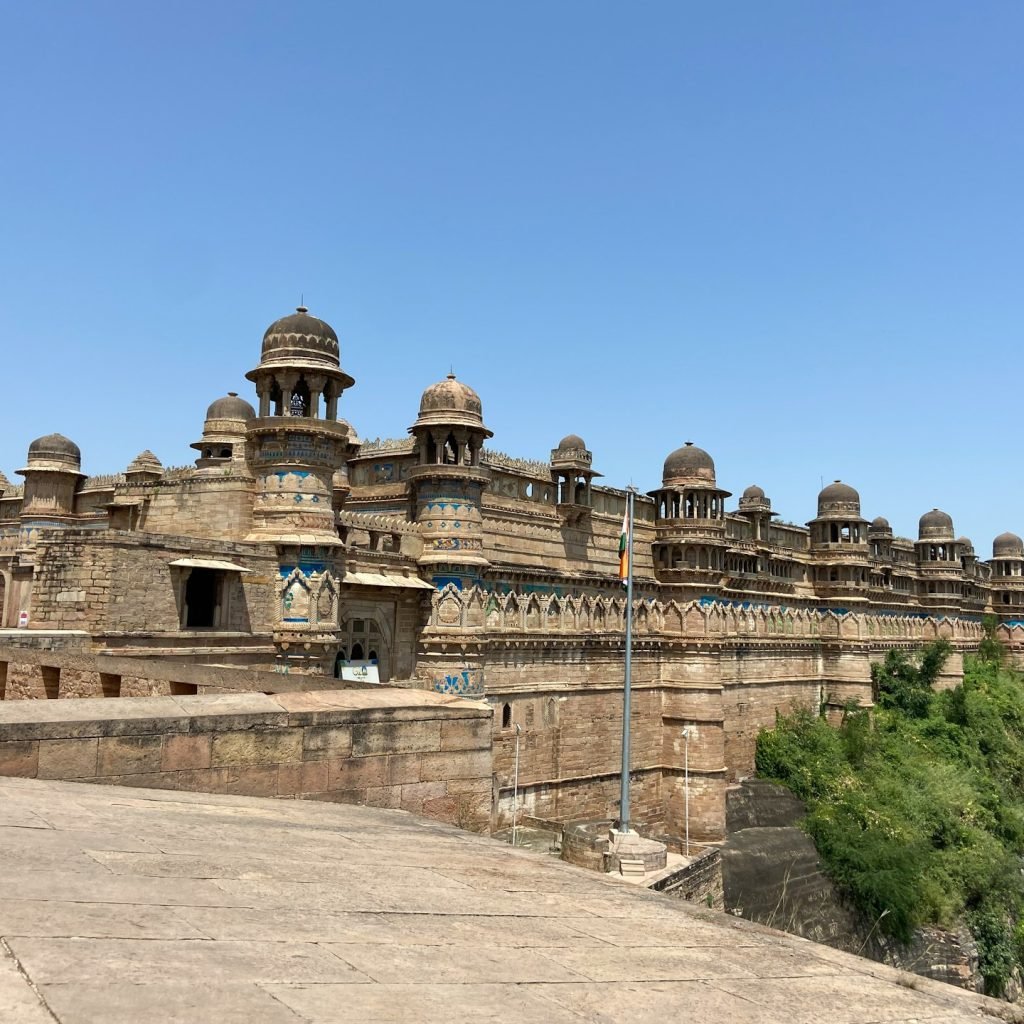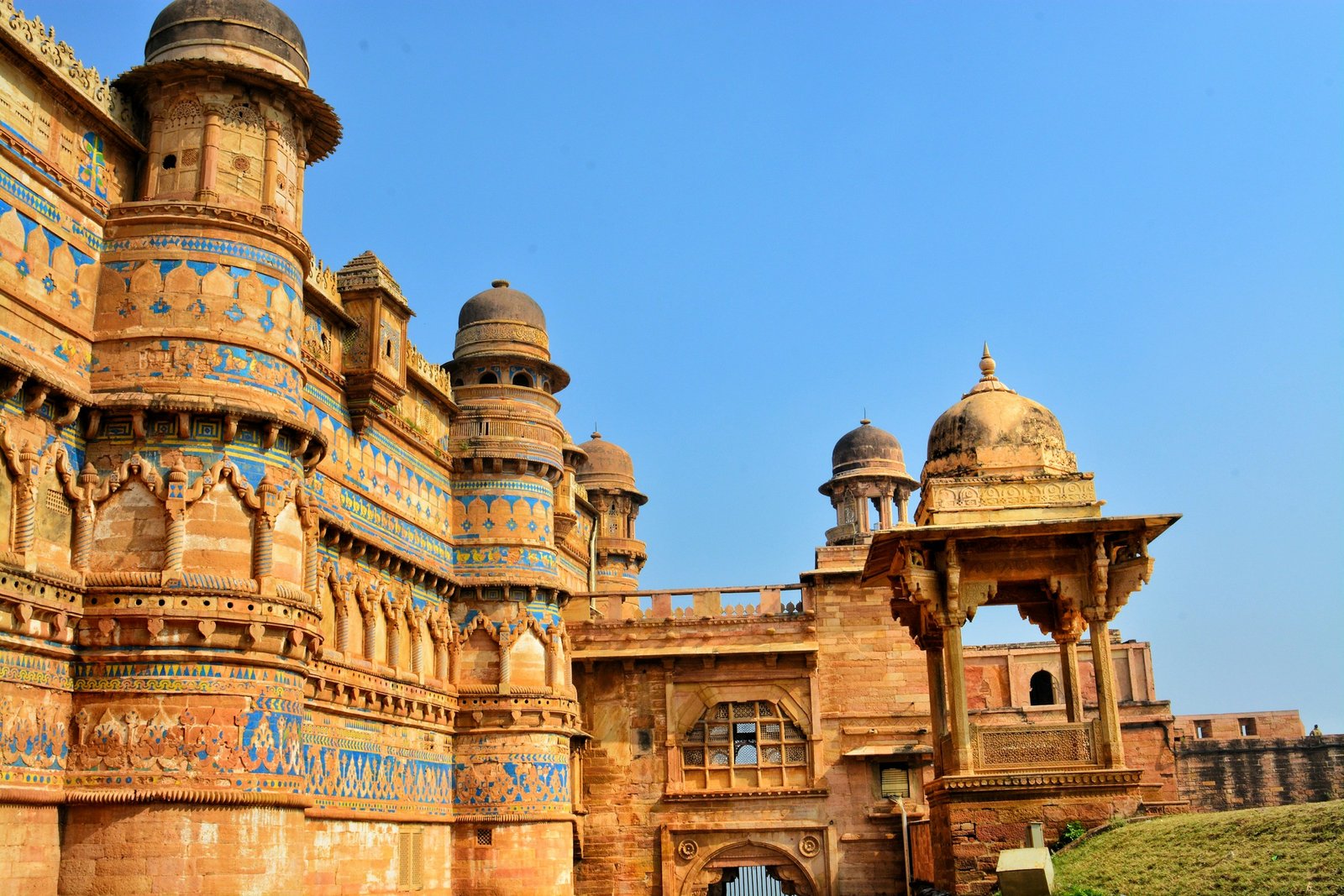Gwalior Fort Introduction
Gwalior Fort is one of India’s most magnificent hill forts, often praised as the “pearl among fortresses of Hind” by Mughal Emperor Babur. Gwalior Fort rises above the city of Gwalior in Madhya Pradesh, built on an imposing sandstone hill that dominates the landscape. Gwalior Fort combines military strength with spiritual sanctity, historical significance, and architectural grandeur. Gwalior Fort is not only a fort but also a living chronicle of dynasties, saints, and legends that have shaped the cultural fabric of India.

Gwalior Fort Origins and Legendary Foundation
Gwalior Fort is believed to have been founded as early as the 6th century, though legends trace its roots further back. Gwalior Fort legend tells of a local chieftain, Suraj Sen, who was cured of leprosy by sage Gwalipa after drinking sacred water from a pond. Gwalior Fort owes its name to the sage, as the grateful king built fortifications around the site and established a settlement. Gwalior Fort thus began as both a military stronghold and a site of miraculous healing, cementing its dual identity in history.
Gwalior Fort and Its Dynasties Through the Ages
Gwalior Fort has witnessed the rule of several dynasties including the Tomars, Mughals, Marathas, and Scindias. Gwalior Fort under the Tomar dynasty reached its artistic zenith, especially under Raja Man Singh Tomar in the 15th century. Gwalior Fort later came under Mughal rule, becoming a prized possession due to its strategic importance. Gwalior Fort passed into Maratha hands in the 18th century and eventually under the Scindia family, who remain associated with the city of Gwalior to this day. Gwalior Fort’s timeline reflects the power struggles of Central India and its importance as a seat of authority.
Gwalior Fort Man Mandir Palace – The Painted Jewel
Gwalior Fort Man Mandir Palace, built by Raja Man Singh Tomar, is the architectural highlight of the fort. Gwalior Fort Man Mandir Palace is renowned for its vivid blue, green, and yellow tile work that decorates the outer walls, earning it the title Painted Palace. Gwalior Fort Man Mandir interiors reveal stone-carved lattices, ornate windows, and underground chambers once used by queens and musicians. Gwalior Fort Man Mandir represents the luxurious side of medieval Indian forts, balancing aesthetics with defensive architecture.
Gwalior Fort Gurjari Mahal – The Palace of Love
Gwalior Fort Gurjari Mahal was constructed by Raja Man Singh Tomar for his queen Mrignayani, who demanded a separate palace with a constant supply of water from the nearby Rai River. Gwalior Fort Gurjari Mahal today functions as an archaeological museum, showcasing rare sculptures from the 1st and 2nd centuries, terracotta figurines, inscriptions, and coins. Gwalior Fort Gurjari Mahal is a testimony to the romance of the Tomar dynasty and a showcase of central Indian artistry.
Gwalior Fort Sacred Contribution to Mathematics – The Zero Inscription
Gwalior Fort is world-renowned among mathematicians for its inscription of the numeral zero. Gwalior Fort inscription dating back to the 9th century AD, located in the Chaturbhuj Temple, is one of the oldest records of the digit zero in human history. Gwalior Fort thus holds immense significance in the evolution of mathematics, making it not only a historical treasure but also a scientific landmark. Gwalior Fort proves how India contributed to global knowledge centuries before modern civilization acknowledged it.
Gwalior Fort Jain Rock-Cut Sculptures – Spiritual Colossi
The cliffs are adorned with colossal rock-cut sculptures of Jain Tirthankaras. Gwalior Fort Siddhachal and Gopachal hills display more than 1,500 statues carved directly into sandstone between the 7th and 15th centuries. Gwalior Fort Jain figures include a 58-feet tall statue of Adinath, one of the largest of its kind in the world. Gwalior Fort Jain monuments remain sites of active pilgrimage and devotion, their serene expressions and colossal size inspiring awe among visitors.
Gwalior Fort Teli ka Mandir – Fusion of Styles
Teli ka Mandir is one of the most striking temples inside the fort. Gwalior Fort Teli ka Mandir stands 100 feet tall and uniquely combines Nagara (North Indian) and Dravidian (South Indian) architectural styles. Gwalior Fort temple, dedicated to Lord Vishnu, features a massive Garuda emblem on its exterior. Gwalior Fort Teli ka Mandir highlights the cultural exchange and experimentation in architecture that flourished during the 9th century.
Gwalior Fort Saas Bahu Temples – Carved Symmetry
Saas Bahu Temples, also called Sahastrabahu Temples, are twin shrines built in the 11th century by King Mahipala. Gwalior Fort temples are dedicated to Lord Vishnu in his Padmanabha form. Gwalior Fort Saas Bahu complex features intricately carved pillars, domes, and floral motifs that resemble temple architecture of Rajasthan. Gwalior Fort Saas Bahu shrines are masterpieces of symmetry, reflecting the advanced craftsmanship of their era.
Gwalior Fort Gurdwara Data Bandi Chhor – Symbol of Liberation
Gurdwara Data Bandi Chhor commemorates the imprisonment of Guru Hargobind Sahib, the sixth Sikh Guru, by Emperor Jahangir. Gwalior Fort legend says Guru Hargobind was released on Diwali but refused to leave without freeing 52 Hindu kings also imprisoned there. Gwalior Fort thus became the site of Bandi Chhor Divas, celebrated as a Sikh festival of liberation. Gwalior Fort Gurdwara today is a serene place of worship attracting pilgrims worldwide.
Gwalior Fort Sound and Light Show – Nightly Spectacle
Gwalior Fort hosts a mesmerizing Sound and Light Show in the evenings, narrating the fort’s glorious past. Gwalior Fort show, conducted in Hindi and English, combines music, narration, and lighting to bring alive the tales of Tomars, Mughals, and Scindias. Gwalior Fort Sound and Light experience leaves visitors spellbound, making it one of the most memorable ways to explore history.
Gwalior Fort Entry Timings and Tickets
Gwalior Fort remains open daily from 6:00 AM to 5:30 PM. Gwalior Fort ticket prices are approximately ₹75 for Indian visitors and ₹250 for foreign tourists. Gwalior Fort entry includes access to palaces, temples, and museums inside the complex. Gwalior Fort also offers discounts for students and group tours, making it accessible to all categories of travelers.
Gwalior Fort Best Time to Visit
Gwalior Fort is best visited between October and March, when the weather is pleasant for walking across the expansive fort complex. Gwalior Fort in summer months can be extremely hot due to its sandstone surface and hilltop location. Gwalior Fort in monsoon offers a green landscape but occasional rains may interrupt sightseeing. Gwalior Fort during winter also coincides with the Gwalior Music Festival, adding cultural flavor to the visit.
Gwalior Fort Travel Guide – How to Reach
Gwalior Fort is easily accessible by air, rail, and road. Gwalior Fort nearest airport is Gwalior Airport (Rajmata Vijaya Raje Scindia Airport), about 10 km from the fort, with flights to Delhi, Mumbai, and other metros. Gwalior Fort is well-connected by train, with Gwalior Junction being a major station on the Delhi–Mumbai route. Gwalior Fort is also accessible by road from Agra (120 km), Jhansi (100 km), and Delhi (330 km).
Gwalior Fort Nearby Attractions
Gwalior Fort visit can be combined with several nearby attractions. Gwalior Fort travelers often explore Jai Vilas Palace, a European-style royal residence of the Scindia family. Gwalior Fort visitors can also enjoy the Sun Temple, inspired by Konark, and the Tomb of Tansen, the legendary musician of Akbar’s court. Gwalior Fort sightseeing pairs well with excursions to Datia Palace and Orchha, both within driving distance.
Gwalior Fort Why It Should Be on Your Bucket List
Gwalior Fort stands as a timeless monument that combines romance, valor, science, and spirituality. Gwalior Fort is not just a citadel but a cultural tapestry reflecting the essence of India. Gwalior Fort captures the legacy of Rajput kings, Mughal emperors, Jain saints, and Sikh Gurus within its massive sandstone walls. Gwalior Fort must be visited for its architectural gems, legendary stories, and panoramic city views.
Gwalior Fort Travel With Travel Into India
Gwalior Fort tours are best experienced with curated itineraries that balance luxury and cultural immersion. Gwalior Fort journeys arranged by Travel Into India include expert guides, heritage hotel stays, and private transfers. Gwalior Fort exploration can be part of an extended Golden Triangle Tour with Gwalior Extension, or a standalone cultural journey into Madhya Pradesh. Gwalior Fort travel bookings can be made by writing to 📩 bookings@travelintoindia.com.


0 Comment